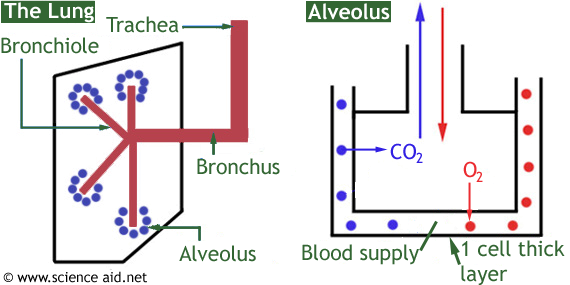Respiratory System; Breathing and Respiraion
Edited by Jamie (ScienceAid Editor), Taylor (ScienceAid Editor)
Breathing
This area is covered in a pleural membrane, forming the airtight pleural cavity, which allows breathing to take place. Air is drawn in and out of the lungs by changes in pressure and volume.
- 1Intercostal muscles contract, moving chest up and out; the diaphragm contracts and flattens. These increase the volume, so decrease the pressure, thus drawing air into the lungs.Inhale'.Advertisement
- 2Intercostal muscles relax, chest moves down and in. The diaphragm relaxes, and domes upwards. Volume decreases, pressure increases and air is forced out of the lungs.Exhale.
Here is the structure of the lungs and an alveolus:
Air goes into the lungs via the trachea, through the bronchi, bronchioles and then into the alveoli, where CO2 diffuses out of the blood, into the alveoli and is exhaled. And O2 diffuses into the blood stream and is transported around the body see circulation
Respiration
Please see the main page respiration in Biochemistry.
Controlling Breathing
It is vital that we can control the rate of breathing to maintain a constant carbon dioxide and oxygen level in the body. This is done by three different processes which are coordinated by the medulla in the brain.
- 1In the lungs are stretch receptors that recognize how inflated the lungs are. When they reach a certain point, they are sent a message to deflate.Stretch Receptors.
- 2In the aorta, are chemoreceptor cells. These can detect the concentration of carbon dioxide in the blood. If it gets too high, they will send a message to increase the rate of breathing.Chemoreceptors.
- 3Medulla And finally there is the medulla itself, which also responds to the levels of carbon dioxide in the blood.
Referencing this Article
If you need to reference this article in your work, you can copy-paste the following depending on your required format:
APA (American Psychological Association)
Respiratory System; Breathing and Respiraion. (2017). In ScienceAid. Retrieved Apr 25, 2024, from https://scienceaid.net/biology/humans/lungs.html
MLA (Modern Language Association) "Respiratory System; Breathing and Respiraion." ScienceAid, scienceaid.net/biology/humans/lungs.html Accessed 25 Apr 2024.
Chicago / Turabian ScienceAid.net. "Respiratory System; Breathing and Respiraion." Accessed Apr 25, 2024. https://scienceaid.net/biology/humans/lungs.html.
If you have problems with any of the steps in this article, please ask a question for more help, or post in the comments section below.
Comments
Article Info
Categories : Humans
Recent edits by: Jamie (ScienceAid Editor)





